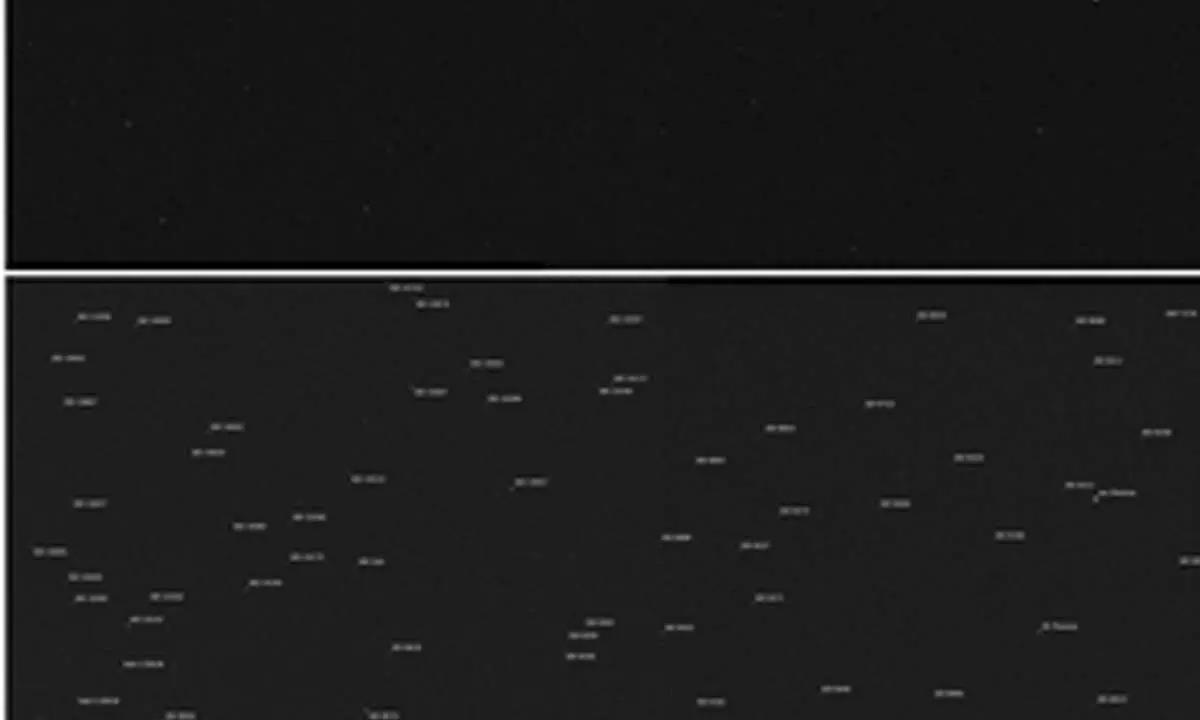Live
- Delhi: Sarod maestro enthrals music lovers at NDMC's concert
- IPL 2025: Nitish's 81 powers RR to 182 against Chennai Super Kings
- Delhi: AAP, BJP cross swords over fate of scheme for road accident victims
- Antidepressants linked to substantial increase in sudden cardiac death risk: Study
- ‘Donkey route’: NIA arrests accused involved in human trafficking to US
- WAVES 2025 set to magnify India's creative strength: Centre
- CM Revanth Reddy Outlines Vision for Telangana’s Development
- Bandi Sanjay Criticises Telangana Government Over Fine Rice Scheme
- CM Revanth Reddy launches Fine Rice Scheme for the poor in Telangana
- Rising Temperatures in Telangana: Orange Alert Issued for 15 Districts

NASA's Psyche spacecraft, which lifted off in October in search of gold, diamond on an asteroid, has retrieved the first images -- a milestone called "first light", the US space agency announced on Wednesday.
Washington: NASA's Psyche spacecraft, which lifted off in October in search of gold, diamond on an asteroid, has retrieved the first images -- a milestone called "first light", the US space agency announced on Wednesday.
In the eight weeks since it left Earth on October 13, the orbiter has performed one successful operation after another, powering on scientific instruments, streaming data toward home, and setting a deep-space record with its electric thrusters.
On December 4, the mission turned on Psyche's twin cameras and retrieved the first images.
The imager instrument, which consists of a pair of identical cameras, captured a total of 68 images, all within a star field in the constellation Pisces.
The imager team is using the data to verify proper commanding, telemetry analysis, and calibration of the images.
"These initial images are only a curtain-opener," said Jim Bell, instrument lead of the Psyche imager at Arizona State University.
"For the team that designed and operates this sophisticated instrument, first light is a thrill.
"We start checking out the cameras with star images like these, then in 2026 we'll take test images of Mars during the spacecraft’s flyby. And finally, in 2029 we’ll get our most exciting images yet -- of our target asteroid Psyche," Bell said.
The imager takes pictures through multiple colour filters, all of which were tested in these initial observations.
With the filters, the team will use photographs in wavelengths of light both visible and invisible to the human eye to help determine the composition of the metal-rich asteroid Psyche.
The imager team will also use the data to create 3D maps of the asteroid to better understand its geology, which will give clues about Psyche’s history.
Earlier in the mission, in late October, the team powered on the magnetometer to get crucial data to determine how the asteroid formed.
Shortly after being powered on, the magnetometer gave scientists an unexpected gift: It detected a solar eruption, a common occurrence called a coronal mass ejection, where the Sun expels large quantities of magnetised plasma.
Data collected so far confirms that the magnetometer can precisely detect very small magnetic fields. It also confirms that the spacecraft is magnetically "quiet".
Meanwhile on November 8, the team also fired up two of the four electric propulsion thrusters, setting a record: the first-ever use of Hall-effect thrusters in deep space.
Until now, they'd been used only on spacecraft going as far as lunar orbit.
By expelling charged atoms, or ions, of xenon gas, the ultra-efficient thrusters will propel the spacecraft to the asteroid (3.6-billion-kilometer journey) and help it manoeuvre in orbit.
Less than a week later, on November 14, the technology demonstration built into the spacecraft, an experiment called Deep Space Optical Communications (DSOC), set its own record.
DSOC achieved first light by sending and receiving optical data from far beyond -- 16 million kilometres away -- the Moon.
It's the farthest-ever demonstration of optical communications.
The Psyche team has also successfully powered on the gamma-ray detecting component of its third science instrument, the gamma-ray and neutron spectrometer.
Next, the instrument’s neutron-detecting sensors will be turned on the week of December 11. Together those capabilities will help the team determine the chemical elements that make up the asteroid’s surface material.
Psyche is the 14th mission selected as part of NASA's Discovery Programme.
The spacecraft is currently 26 million kilometres from Earth, and will arrive at its destination -- the asteroid Psyche in the main asteroid belt between Mars and Jupiter -- in 2029.

© 2025 Hyderabad Media House Limited/The Hans India. All rights reserved. Powered by hocalwire.com






